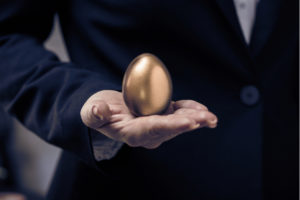
Listen, this is how I want you to think about yourself as an investor. Imagine you own a wonderful business. We’ll call it Gold Goose Inc. It pays you a handsome salary, plus annual increases to keep up with the times. You retire with a nest egg worth more than you ever thought you’d be worth, and you need to invest it. What do you do?
For Your Survival Guy, the next best thing to Gold Goose Inc. is to invest in a basket of eggs that pay dividends that regularly increase to keep pace with inflation. That’s exactly what Young Research’s Retirement Compounders stocks try to do. See below.
Unfortunately, too many investors believe investing is about the stock market going up in value. That’s not how to think about it as far as I’m concerned. Think about your home or farm, for example. Your goal should be to own it by retiring your mortgage. Because when times are tough, we know what can happen if mortgage payments are missed, and the bank comes swooping in like a vulture.
OK, with that in mind, as a stock investor, you’re the bank providing your capital to a company to work with. In return, you’re paid part of the earnings in the form of dividends with regular increases to boot. All of a sudden, after several years of payments, your initial capital investment has been paid back. Now, future payments are “house” money, so to speak. Read this for a real-life example illustrated in the Summer 2021 edition of the Handbook of Dividend Achievers.
Take for example a household name, Coca-Cola Co (NYSE: KO). It consistently raised its dividend every year for 49 years as of January 2012. If you had bought its stock on January 13, 2012 (when its stock was in a slight dip and priced at $66.99), you would have been able to benefit from the 0.51¢ per share dividend it declared on February 16 and that went ex-dividend on March 13 and paid on April 1. If you had bought, say 100 shares, the consideration would have cost you $6,699 (that is, without factoring in any brokerage fees). Assuming it continues to raise its dividend by about 7% a year, the dividends alone you receive would have paid off the consideration for the stock after about 17 and a half years. After that time you would be receiving a dividend, every year, of $644.40 per year, and yet you would have received your initial outlay of $6,699 back in the dividends you had received over the years. Plus you still own the stock. This is hypothetical and there are other variables. The point is that investing in dividend stocks that have a track record of dividend growth provide stability and certainty and this allows for better planning.
Action Line: Do you have a Golden Goose Inc. you want to keep in the family and nurture? Pass this along to someone you care about to keep the bank off your farm.



